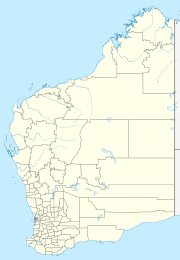Frankland River, Western Australia facts for kids
Quick facts for kids Frankland RiverWestern Australia |
|||||||||
|---|---|---|---|---|---|---|---|---|---|
| Established | 1947 | ||||||||
| Postcode(s) | 6396 | ||||||||
| Elevation | 230 m (755 ft) | ||||||||
| Area | [convert: needs a number] | ||||||||
| Location | |||||||||
| LGA(s) | Shire of Cranbrook | ||||||||
| State electorate(s) | Roe | ||||||||
| Federal Division(s) | O'Connor | ||||||||
|
|||||||||
Frankland River is a small town in the Great Southern region of Western Australia. It's located about 360 kilometers (224 miles) southeast of Perth, the state's capital city. The town is named after the Frankland River, which flows about 6 kilometers (3.7 miles) to its east. In 2006, about 380 people lived in Frankland River.
Contents
History of Frankland River
How Frankland River Got Its Name
The area of Frankland River was named in 1829 by a surgeon named Thomas Braidwood Wilson. He was exploring the land while his ship was being fixed in Albany. Wilson named the Frankland River and Mount Frankland after George Frankland. George Frankland was a very important surveyor in Van Diemen's Land (which is now called Tasmania) at that time.
Wilson's explorations showed that the land was good for farming. This encouraged many settlers to move into the area. The first European settlers arrived in 1857.
Growth of the Town
The government decided to set aside land for a town here by 1909. They built a hall and a school. However, the town itself wasn't officially declared until 1947.
The town and region were known as Frankland River until 1935. Then, a local post office was built. The postmaster shortened the name to "Frankland" because "Frankland River" was too long for signs and documents. But in 2007, the name was changed back to Frankland River.
Early Settlers and Farming
Western Australia's first European settlement began in Albany in 1826. Pioneers slowly explored the land, looking for good areas for farming. The Frankland area had good soil, steady rainfall, and many rivers and lakes. Because of this, settlers started clearing the native forests to create pastures for animals and fields for crops.
A retired sea captain named John Hassell helped open up large areas in the south during the 1850s. He had many sheep. Shepherds would take these sheep to the Frankland area because it had natural pastures and many small creeks. The permanent water from the Frankland and Gordon Rivers, and lakes like Nunijup, also made the area good for animals, especially in summer.
Families soon followed the shepherds, looking for land to settle. The completion of the Great Southern Railway in 1889 also helped the area grow. Even though the railway went through Cranbrook, timber workers in Frankland were busy cutting wood for railway sleepers. Many of these workers later settled on land in the area.
After World War II, more people moved to Frankland River. This included war veterans, mill workers, shearing teams, and people who worked on local vineyards and olive groves.
Education in Frankland River
When schooling first started in Frankland River, there was no school building. The first teacher was given a tent to live in and to teach from. Before World War II, classes were held in the town hall.
Today, the local school has about 60 to 70 students. It teaches children from kindergarten up to year 6.
Frankland River Wine Region
Frankland River is one of the five main areas that make up the Great Southern wine region in Western Australia. This region is known for growing grapes and making wine. Frankland River is located in the northwestern part of the Great Southern wine region.


